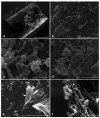Plastic biliary stent occlusion: factors involved and possible preventive approaches
- PMID: 17456835
- PMCID: PMC1855334
- DOI: 10.3121/cmr.2007.683
Plastic biliary stent occlusion: factors involved and possible preventive approaches
Abstract
Endoscopic biliary stenting is today the most common palliative treatment for patients suffering from obstructive jaundice associated with malignant hepatobiliary tumors or benign strictures. However, recurrent jaundice, with or without cholangitis, is a major complication of a biliary endoprosthesis insertion. Thus, stent removal and replacement with a new one frequently occurs as a consequence of device blockage caused by microbial biofilm growth and biliary sludge accumulation in the lumen. Factors and mechanisms involved in plastic stent clogging arising from epidemiological, clinical and experimental data, as well as the possible strategies to prevent biliary stent failure, will be reviewed and discussed.
Figures

Similar articles
-
[Application of biliary stents in endoscopic stenting of biliary ducts].Polim Med. 2006;36(3):3-10. Polim Med. 2006. PMID: 17190288 Review. Polish.
-
[Implantation of plastic and metal stents to biliary tract in obstructive jaundice in material of Surgery Department of 4th Military Clinical Hospital in Wroclaw].Polim Med. 2013 Jan-Mar;43(1):5-9. Polim Med. 2013. PMID: 23808190 Polish.
-
Endoscopic stenting for palliation of malignant biliary obstruction. A review of progress in the last 15 years.Dig Dis Sci. 1995 Jun;40(6):1167-73. doi: 10.1007/BF02065519. Dig Dis Sci. 1995. PMID: 7540126 Review.
-
Expandable metal biliary stenting in patients with recurrent premature polyethylene stent occlusion.Am J Gastroenterol. 2001 May;96(5):1435-40. doi: 10.1111/j.1572-0241.2001.03795.x. Am J Gastroenterol. 2001. PMID: 11374679
-
Prevention of biliary stent clogging: a clinical review.Am J Gastroenterol. 1996 Jul;91(7):1301-8. Am J Gastroenterol. 1996. PMID: 8677983 Review.
Cited by
-
Development of an intrabiliary MR imaging-monitored local agent delivery technique: a feasibility study in pigs.Radiology. 2012 Mar;262(3):846-52. doi: 10.1148/radiol.11110723. Radiology. 2012. PMID: 22357886 Free PMC article.
-
Biliary stenting in patients with malignant biliary obstruction: comparison of double layer, plastic and metal stents.Dig Dis Sci. 2013 Jul;58(7):2088-92. doi: 10.1007/s10620-013-2607-z. Epub 2013 Mar 1. Dig Dis Sci. 2013. PMID: 23456505
-
Epidemiology and Resistance Patterns of Bacterial and Fungal Colonization of Biliary Plastic Stents: A Prospective Cohort Study.PLoS One. 2016 May 12;11(5):e0155479. doi: 10.1371/journal.pone.0155479. eCollection 2016. PLoS One. 2016. PMID: 27171497 Free PMC article.
-
Significance of controlling chronic proliferative cholangitis in the treatment of hepatolithiasis.World J Surg. 2009 Oct;33(10):2155-60. doi: 10.1007/s00268-009-0154-8. World J Surg. 2009. PMID: 19641953 Review.
-
Does prophylactic stent insertion to the common bile duct during endoscopic retrograde cholangiopancreatography (ERCP) before cholecystectomy have any impact on the rate of biliary complications?Surg Endosc. 2013 Dec;27(12):4620-4. doi: 10.1007/s00464-013-3082-5. Epub 2013 Jul 17. Surg Endosc. 2013. PMID: 23860609
References
-
- Soehendra N, Reynders-Frederix V. Palliative bile duct drainage - a new endoscopic method of introducing a transpapillary drain. Endoscopy 1980;12:8–11. - PubMed
-
- Dowidar N, Kolmos HJ, Matzen P. Experimental clogging of biliary endoprostheses. Role of bacteria, endoprosthesis material, and design. Scand J Gastroenterol 1992;27:77–80. - PubMed
-
- McAllister EW, Carey LC, Brady PG, Heller R, Kovacs SG. The role of polymeric surface smoothness of biliary stents in bacterial adherence, biofilm deposition, and stent occlusion. Gastrointest Endosc 1993;39:422–425. - PubMed
-
- Weickert U, Venzke T, Konig J, Janssen J, Remberger K, Greiner L. Why do bilioduodenal plastic stents become occluded? A clinical and pathological investigation on 100 consecutive patients. Endoscopy 2001;33:786–790. - PubMed
Publication types
MeSH terms
Substances
LinkOut - more resources
Full Text Sources
Other Literature Sources
Medical
